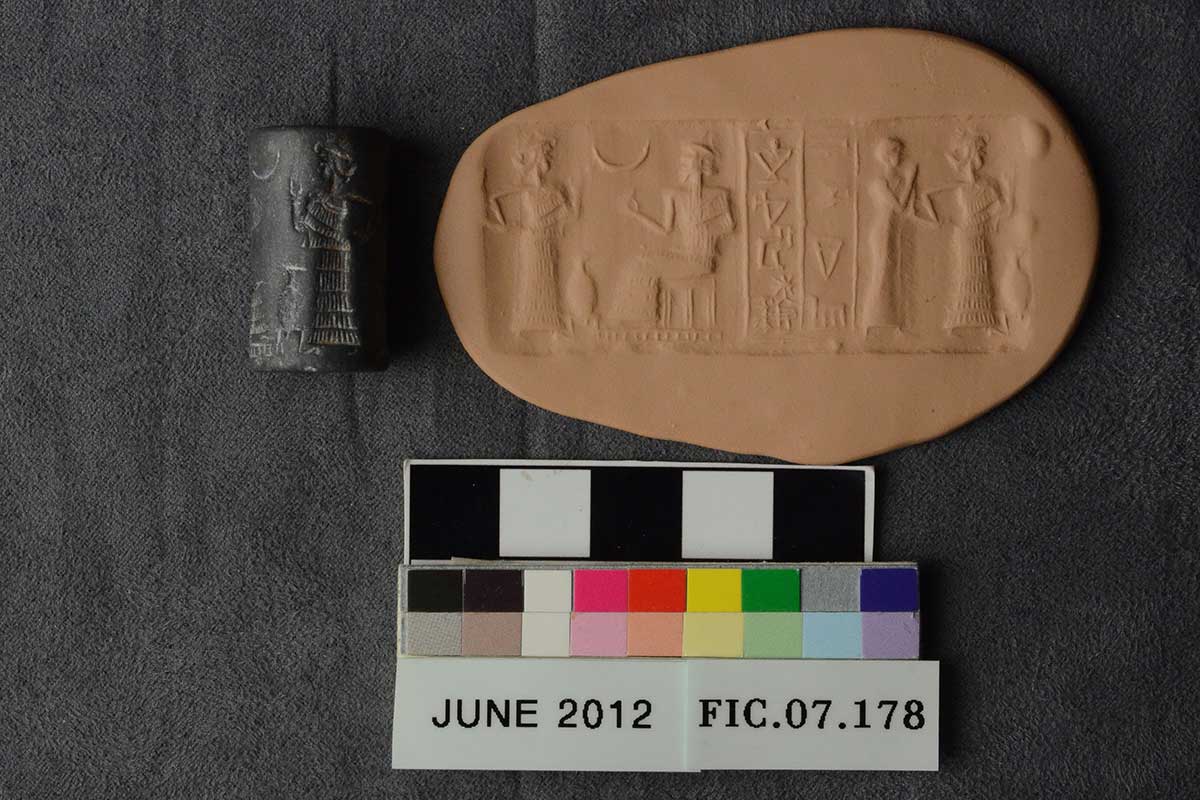Ancient Cylinder Seals
Presentation before a God
By Anna Glenn

Measurements: Length: 2.6 cm, Width: 1.5 cm
Material: Stone, Hematite
Date/Culture: Sumerian, 2112-2004 B.C.E.
Provenance: Unknown
Description
A clean-shaven man is presented before a seated, bearded god. In the spaces between the figures are a cluster of three drill-holes, a crescent moon, and a tall, narrow-necked jar on a small table. An inscription, written in cuneiform, reads: a-ḫa?-ni-šu // arad₂ nu-ur₂-dšul-gi
Discussion
The scene on this seal represents the standard “presentation scene” of the Ur III period, dating to ca. 2112-2004 B.C.E. Such scenes depict a human worshipper – probably representing the owner of the seal – led by a goddess before an enthroned deity. The latter two figures are identified as deities by their horned hats – a symbol of divinity in Mesopotamian from the 3rd millennium onward. The goddess is a type of personal, protective deity known in Sumerian as lama and in Akkadian as lamassu, who often appears in presentation scenes “interceding” on behalf of a mortal. In scenes of the Ur III period, she leads him before a seated deity; in later periods, she stands behind him and assumes a suppliant posture.
The enthroned deity does not appear to represent any one, particular member of the Mesopotamian pantheon. Although the crescent moon – a standard feature in Ur III presentation scenes – was, in later periods, associated with Mesopotamian moon god Sîn, there is no evidence for such an association here, and the crescent moon appears above gods, goddesses and deified kings alike.
The inscription on this seal identifies its owner as “Aḫa-nīšu, servant of Nūr-Šulgi.” Aḫa-nīšu was a fairly common name during the Ur III and later periods; the name Nūr-Šulgi, though less common, is also attested (e.g., on another presentation-scene seal also dating to the Ur III period [BM 89180, published in Collon 1982 no. 452]). His name means “light of Šulgi” (Šulgi being the name of a deified Ur III-dynasty king).
While the configuration of the figures in this scene is most typical of the Ur III period, it also does occur on the earliest seals of the subsequent Old Babylonian period, appearing as late as ca. 1900 B.C.E.. Since there was no clear break between the styles of these two periods, it is possible that this seal dates to the early second millennium, rather than the Ur III period. Although one of the names in the inscription incorporates the name of an Ur III king, similar names are also attested in the early Old Babylonian period. Likewise, the name Aḫa-nīšu appears in both periods. The formula “PN, servant of PN,” while known on a few other Ur III seals, is much more typical of the Old Babylonian period.
On the other hand, even if the inscription can be dated to the Old Babylonian period, seal inscriptions are generally unreliable for determining a seal’s original date: it was not uncommon for inscriptions to be added to seals many years – even centuries – after their original cutting. Thus, while an Old Babylonian inscription would indicate a date no later than the Old Babylonian period, it may tell us nothing about the seal’s earliest possible cutting.
References
Black, Jeremy and Anthony Green, 1992. Gods, Demons and Symbols of Ancient Mesopotamia: An Illustrated Dictionary. London: British Museum Press.
Collon, Dominique, 1982. Catalogue of the Western Asiatic Seals in the British Museum: Cylinder Seals II. Akkadian – Post Akkadian – Ur III – Periods. London: British Museum Publications.
—1986. Catalogue of the Western Asiatic Seals in the British Museum: Cylinder Seals III. Isin-Larsa and Old Babylonian Periods. London: British Museum Publications.
—1987. First Impressions: Cylinder Seals in the Ancient Near East. London: British Museum Publications.
Cuneiform Digital Library Initiative. UCLA and Max Planck Institute (accessed August, 2012). Database of Neo-Sumerian Texts. Edited by Manuel Molina. Funded by Ministerio de Economía y Competitividad (accessed August, 2012).
Keel-Leu, Hildi and Beatrice Teissier, 2004. The Ancient Near Eastern Cylinder Seals of the Collections “Bible+Orient” of the University of Fribourg. Orbis Biblicus et Orientalis 200. Fribourg: Academic Press; Göttingen: Vandenhoeck & Ruprecht.
Kist, Joost, 2003. Ancient Near Eastern Seals from the Kist collection: Three Millennia of Miniature Reliefs. Culture and History of the Ancient Near East, Vol. 18. Leiden: Brill.
Merrillees, Parvine H, 1990. Cylinder and Stamp Seals in Australian Collections. Deakin University Archaeology Research Unit Occasional Paper 3. Victoria.
Møller, Eva, 1992. Ancient Near Eastern Seals in a Danish Collection. Carsten Niebuhr Institute Publications 11. Copenhagen: Museum Tusculanum Press.
Porada, Edith, ed., 1948. Corpus of Ancient Near Eastern Seals in North American Collections: The Collection of the Pierpont Morgan Library. The Bollingen Series 14 (2 vols.). Washington, D.C.